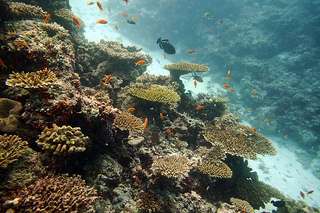Dr Hobbs says that despite 172 coral species living off Christmas Island, the pathogen almost exclusively affected three species, A. clathrata, A. cytherea (pictured) and A. hyacinthus. Credit: Malcolm Browne
A survey of Christmas Island reefs has revealed twice as much plate coral was destroyed by a 2008 disease outbreak than previously feared.
Five years after one of the world's most destructive coral diseases, called white syndrome, plagued Acropora plate corals around the island, Curtin University researchers report 96 per cent of corals died in some places.
Marine biologist Dr Jean-Paul Hobbs says the findings are significant because previous studies have only reported the amount of coral affected by disease.
"Determining how many corals actually die due to the disease is very important, and this study is the first to show that white syndrome can kill nearly every Acropora plate coral on a reef," Dr Hobbs says.
His surveys found white syndrome ravaged Acropora plate coral communities, particularly in shallow waters, with mortality rates more than twice as high as the infection rates initially documented when the disease first hit.
Acropora corals are an important source of food and habitat for marine life, with many species of fish hiding and living under or feeding on it.
While a bacterium called vibrio has been linked to white syndrome, scientists remain unsure of what causes outbreaks or how the disease is transmitted, and little is known about its impact on reefs in the Indian Ocean.
The disease, characterised by a white band appearing on the coral, has been associated with warm ocean temperatures.
White syndrome heavily impacted three species
Dr Hobbs says that despite 172 coral species living off Christmas Island, the pathogen almost exclusively affected three species, A. clathrata, A. cytherea and A. hyacinthus.
Across all the surveyed sites and depths, 36 per cent of Acropora colonies were fatally infected, according to the researchers.
"White syndrome caused a two-and-a-half-fold decrease in Acropora plate coral cover across the study sites, including an eight-fold decrease in the shallows," the report says.
Dr Hobbs says white syndrome has been seen on other reefs in WA, but never before at the levels found at Christmas Island in 2008.
Five years after the outbreak, Dr Hobbs found Acropora plate corals had not recovered.
His team will monitor the reef to document if the loss of coral affects fish populations.
"More research is needed to identify solutions to reducing the outbreak of white syndrome and other coral diseases," he says.
"Reducing local impacts, like pollution, can help reduce stress on the corals and this will make them less susceptible to white syndrome."
Provided by Science Network WA






















